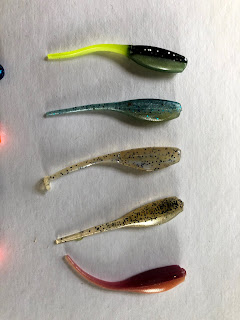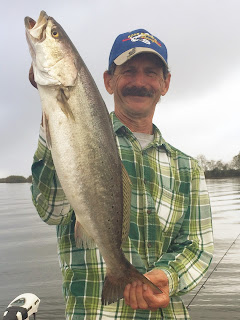Location, Presentation, Style, and Color for Catching Crappie
One thing a good fisher will tell you is that you can learn something new every time you go out. This is true no matter how many years you've been fishing. Modern day technology has certainly made learning something new each trip easier.
It's a given that location is always the number one reason you will be successful or not. No matter the presentation, type of bait, or color that you are using, the area must have fish to catch.
Location is the key for success, but presentation may be the most important reason you will catch fish once you have found them. There are many ways to present your bait to crappie. You can cast, dock shoot, spider rig, pull or push baits, or by drop/tight lining the bait onto the fish.
For those using Garmin's Livescope or Lowrance's Active Target, presentation is made easier. For those who don't have such technology, knowledge and skill are the keys to catching fish. With this modern day technology, one can visualize the bait in relation to the fish you are trying to catch.
Presentation with Livescope or Active Target
Casting:
Casting to targeted fish is usually accomplished by casting a few feet in front of the fish and rolling it past the fish. Most fishers like to keep it just above or even with the fish. Crappie will swim down or chase a bait, but they have to see it first.
Tight lining:
The same goes when dropping or tight lining a bait. You want to present the bait above or in front of the fish. Sometimes you can tell which way a fish is facing, but most of the time this is not the case. Water depth and distance from the fish may determine if you can see the shape and direction a fish is facing. Many times you may have to drop on a fish multiple times to get it to bite.
Spider rigging:
You can also use livescope technology while spider rigging. It is a great way to see how the baits are running in comparison to where you are spotting fish and adjusting accordingly.
Certainly you don't need this modern day marvel to catch fish. But presentation is just as important.
Casting:
Casting for crappie is usually accomplished with spinning or spin cast rod and reels. Typically the baits used for crappie fishing are too light for bait-cast rigs. Many fishers prefer a slow rolling retrieve. Trying different speeds will help you determine at what depths fish may be located. The slower the retrieve the deeper the bait will sink.
Tight lining:
Tight lining around structure usually requires a longer jig pole from 10-13 ft. There are two ways to find where fish are located. First you can ease the bait down slowly, stopping every few inches or feet (depending on water depth) and stopping. The second method is to drop the bait to the bottom and slowly work it back up. One thing I have noticed from scoping is that more times than not, crappie like the bait sitting perfectly still. Stopping the bait for a few seconds may attract more bites.
Spider Rigging:
Spider rigging, for a long time was the way to catch more fish and was the preferred choice of tournament fishers. Spider rigging got its name from how the rods where placed in front of the boat. Fishers would mount 8 rod holders with same or different length rods up to 16ft at different angles to cover more water while slow trolling. (in a spider leg configuration). It is a proven technique that when done correctly will increase productivity. After all when you have 8 poles or more sometimes with two baits attached, you will certainly increase your chances. Plus, spider rigging allows you to try multiple styles and colors, as well as live bait at different depths.
Dock Shooting:
Dock shooting has become another popular way to catch crappie. There is no doubt that at certain times of the year, crappie love boat docks or any structure that provides shade and cover. While spider riggers typically use longer poles up to 16 ft. Dock shooters use shorter rods 5 to 7 foot. These shorter typically spinning rods in combination with a spinning reel seem to be the preferred method for shooting docks. This is accomplished by holding the bait in two/three fingers and bending the rod and letting the bait shoot under the structure. This allows you to skip the bait far enough to reach the targeted fish. Although this is done by feel having some type of side scanning fish finder will help. Livescope can also be beneficial in finding fish under docks. It can show you exactly where the fish are located.
Pulling Cranks:
Another popular way to present your bait in front of crappie is pulling crank baits. Fishers can use lipless or baits with different lip sizes, depending on how deep you need the bait to dive. Style of bait and boat speed are key to catching crappie. Most fishers set 4 to 6 rods in holders in the back of the boat. Rod lengths may vary in order to keep your baits from running together and getting tangled, Unlike dock shooting many fishers use bait casting reels, some with line counters for this presentation. Pulling cranks is certainly more involved and may not be for the novice fisher.
Corking:
One presentation not mentioned in the Scoping section is corking. For many, this is the method of choice. Slip corks will allow you to adjust to deeper water as needed. In shallow water sometimes using the smallest float possible with a jig or live bait is all that is needed. The smaller the float the least resistance for the fish to feel. Depending on how active fish are, "popping" the cork can be effective or sometimes just letting it sit still will produce more fish.
No doubt location is the first step to catching more fish, presentation second, but the real debate maybe what comes next? Is it the style of bait or color. This depends on who you talk to.
The style of bait is determined by the estuary you are fishing and the type of feed available. The larger lakes and reservoirs tend to have great populations of shad, so the style of bait should represent the size of shad the fish are feeding on.
Crappie feed on all types of bait, anywhere from bugs , to shrimp and crawfish. Knowing this will help you pick the style of lure or jig to try. Live bait is always a great option. After-all a lively minnow is hard for crappie to resist. Many fishers catch crappie on earth worms, grass shrimp, crawfish, and even crickets. Style of the lure can also include the weight and size of a lure or jig head/body. Jig heads with blades are also popular. The type of jig tails can also determine whether a fish will bite or not. There are curly tails, split tails, flat tails, tails with multiple feelers and many more. Choosing the right tail could make the difference of getting bit or not. If plastics aren't your style, there are many hand tied hair jigs you can try. There are many, many styles of lures to chose from. Just remember, match the style with what is the natural forage in your particular body of water.
Maybe the biggest controversy of all is color. If you ask 10 different fishers, you will get 10 different answers. So how does the novice chose the right color. Simple, just ask the folks who are willing to tell you. Today there are many color combinations, but to narrow it down will most likely depend on water clarity. The muddier lakes like Grenada, fishers tend to go with brighter colors like orange, chartreuse, and pinks. In stained water, many fishers go with variations of blues, and black in combination with chartreuse.
In clear waters, variations of whites, and clear tails with sparkles work well.
So if you are a novice, weekend warrior fisher and want to increase your chances of catching more crappie Do a little research before you go. It all depends on the right location, the right presentation, the right style of bait, and the right color.
Good luck fishing. Hope to see ya on the water.









Comments
Post a Comment